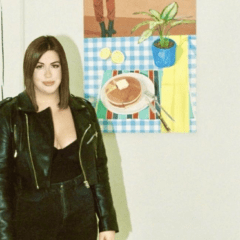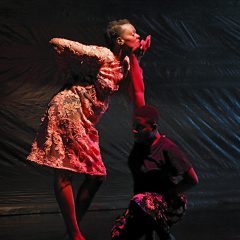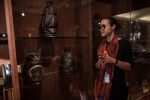As patrons enter to find seats in the Bryn Mawr Hepburn Teaching Theater, Katrina Reid stops and starts in front of a huge, thin plastic screen, reciting a song, fervently yet mostly inaudibly. Stage lights beam into the audience, while the stage itself stays softly rendered. Okwui Okpokwasili moves in excitatory bursts and hypnotic lulls behind the screen, breasts exposed yet blurred. Thuli Dumakude occupies the foreground in a plastic chair while Nehemoyia Young, almost imperceptible at the start, is revealed off to the right, crawling beneath a blanket.
The lighting relents, by degrees, shifting the heat to the performers.
What unfolds over the next hour and a half is nothing short of magic — a multilayered masterpiece both haunting and haunted, revelatory and relentlessly elusive.
Conceived by Brooklyn-based writer, performer, and choreographer Okwui Okpokwasili, Poor People’s TV Room is co-written by Okpokwasili and her husband and longtime collaborator, Peter Born. Born also directs the show and contributes brilliant scenic and lighting design.
In/Visibility
The performance inhabits a shadowy landscape of memory, shifting, twisting, questioning itself as penumbral glimpses of characters question and define themselves and each other. What and who is visible, and to whom, and through what means, fuels the unconquerable electricity of Poor People’s TV Room.
On a small platform, Okpokwasili suckles from Reid’s breast—Reid an indentured house girl whose daughter has died in some senseless act of war. From the perspective of the audience, the platform could be a bed or table, with the two performers horizontal on top of it. A camera hangs above, sending a live feed onto a nearby screen, repainting the scene from this new view with the two now vertical in a domestic room featuring a chair and lamp by a window.
Although it is Okpokwasili who literally consumes Reid in this way, she addresses Reid with an accusatory, fearful tone: “Why are you looking at me, do you want to swallow me whole?”
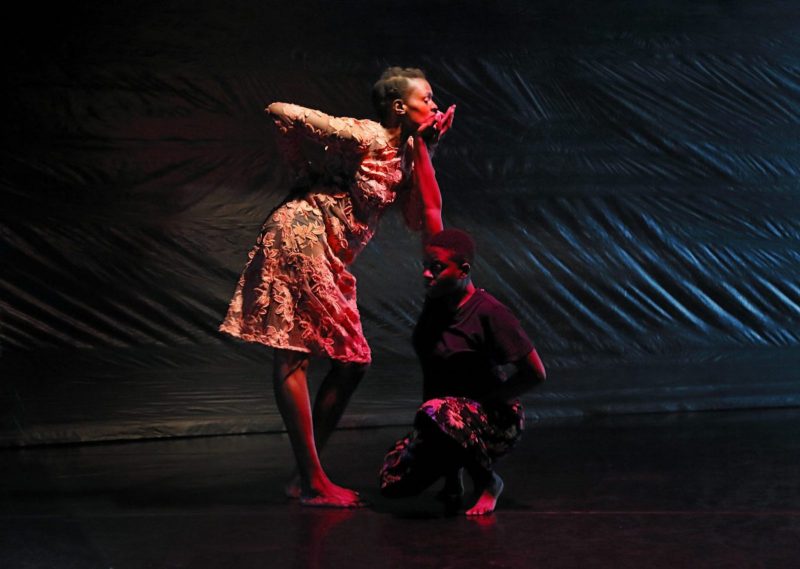
These themes of perspective, of access, of interconnection, and of consumption, comprise a few wiry veins running through the complex circulatory system of this piece. In intimacy and its opposite, the performers toss light and shade like violence, like medicine, without warning, baring the too-much of trauma and its residual demands through tender nuance and stark relief.
The child’s mouth and the mother’s soul
The mature Dumakude and youthful Young typically partner in dance and speech, sparring and echoing each other. Young hangs on the subject of her mother, a “prophetess, nonetheless,” whose visions manifested through her selections of text-emblazoned t-shirts at market. Whatever slogan was imprinted on the shirt she chose was “what would happen.” This image of the market mother as mystic reframes themes of the divine feminine, emerging through and transformed by an atmosphere of capitalist imperialism.
When Dumakude asks, “Who is your mother?,” Young replies, “I never knew my mother, I knew of her.”
“This is a hand,” Dumakude contemplates, opening and closing her fist. “It’s this hand doing it.”
With this motion, she recalls, she manually operated a respirator for her dying daughter. Pumping air into her daughter’s lungs even after hope was lost, she confesses, “the breath was but my own invention.”
Breathing into her hands, she cups and passes this air to Young.
“I don’t prove a point for no reason,” she says, “I don’t waste my breath for no reason.”
More so than any specific story or symbol, it is this charge and exchange of breath, the fact of these bodies, and the reality of this cast exclusively made up of illustrious female artists of color performing this dazzling, painstakingly-wrought piece together that infuses Poor People’s TV Room with its jaw-dropping power. The intentionality of the movement and language transmuted through the primacy of bodies effects an impulse to return to the body, cutting through the plastic divisions of consumerism and white supremacy to the urgency and actuality of specific lives.
Virality and protest
In several interviews, Okpokwasili, who is Nigerian-American, describes Poor People’s TV Room as in part a reaction to the #BringBackOurGirls movement and the 1929 Nigerian Women’s War.
The #BringBackOurGirls campaign, which demanded the Nigerian government rescue the 276 girls kidnapped from a school in Chibok by Boko Haram in April of 2014, went viral with an outpouring of celebrity support. Despite directing attention to the kidnapped schoolgirls, #BringBackOurGirls ultimately recast the Nigerian mothers who founded the protest as helpless victims. As in many social movements created and sustained by the dedicated labor, and justified rage of women of color, at a certain point someone else came in and changed the story.
To date, 113 of the girls are still missing, and none who have returned were rescued. The week of this performance, Boko Haram kidnapped 110 more girls from a school in Dapchi.
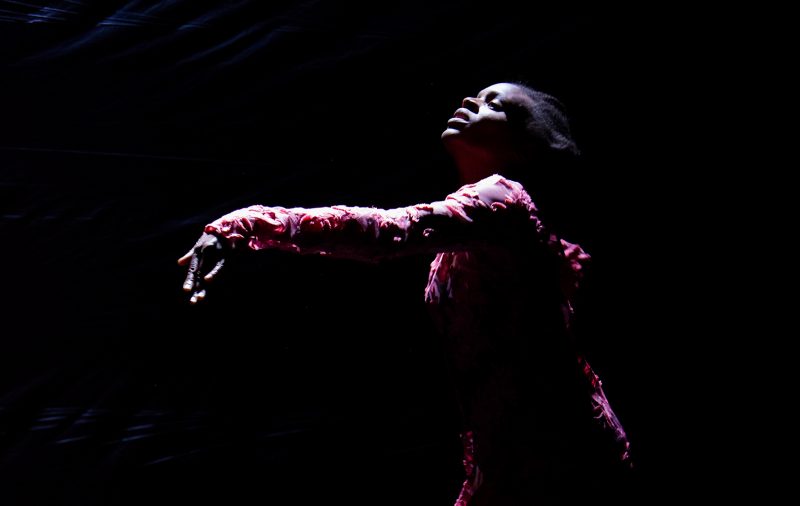
Okpokwasili also heavily researched the 1929 Women’s War, in which thousands of Nigerian women used forms of embodied protest to oppose the violence of colonial rule. Older women, in particular, exposed their breasts and chanted dirty verses to shame men in power. This resistance came to be called the “grand egwu,” with “egwu” translating from Igbo as “dance.” Through script, music, lighting and most powerfully through movement, Poor People’s TV Room testifies to the power of distilled intention as protest.
Bryn Mawr talkback
“This war and these practices,” Okpokwasili explains in a talkback after the show, “are connected to performance.”
Dumakude ponders, regarding war and women, “Why the womb? Why the breast?” Shaking her head, she answers, “the power that we hold in our very quiet place…creates the nation.”
Regarding the arc of Poor People’s TV Room overall and the specifics of character, Okpokwasili clarifies, “I don’t want to get bogged down into a narrative, when I feel like it’s a narrative of bodies.” Song, however, Okpokwasili maintains, was always a part of the piece.
The spellbinding Dumakude chimes in, reflecting on a one-word hymn her South African mother often sang. At Okpokwasili’s request, Dumakude sings it, but on the condition that everyone in the theater join.
“Sometimes I’d be afraid to ask her — how do you feel?” Dumakude says gently.
She continues, “the older I get, the more I understand…the thinking: ‘How am I going to feed my children? There’s a war out there. The neighbor’s child was killed in an explosion’…I didn’t have to understand the words…it was something the song was doing for me.”
“Songs, they hold this energetic space,” Okpokwasili concludes heartily, “I will jettison narrative, I will jettison everything, just to hold on to that energetic space.”


